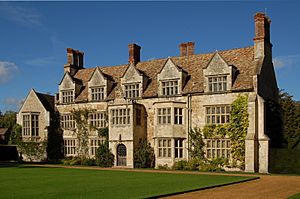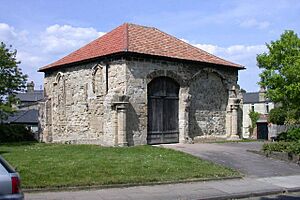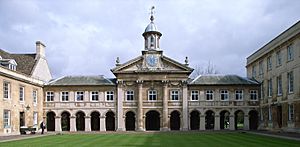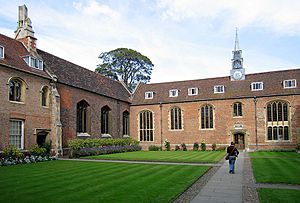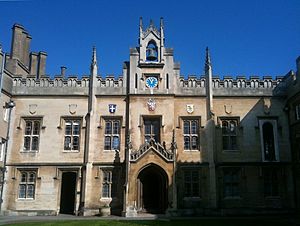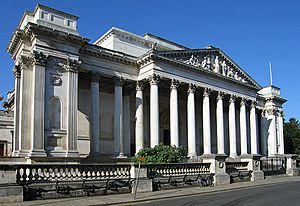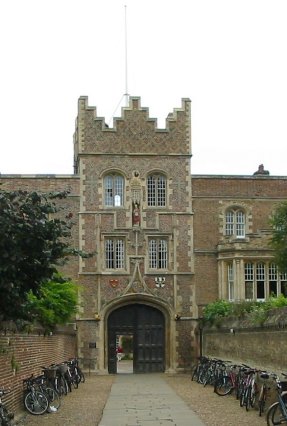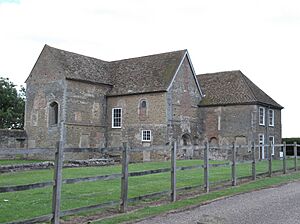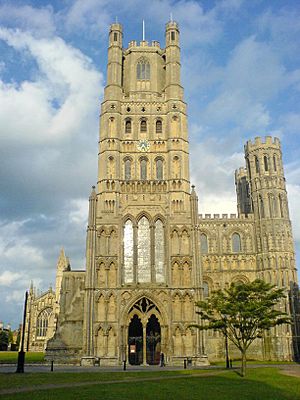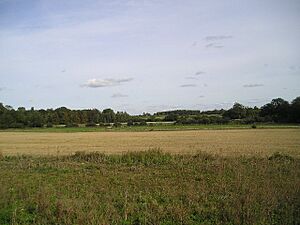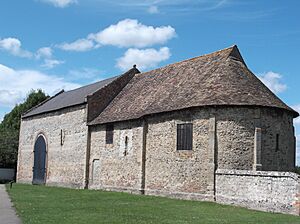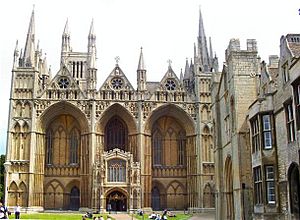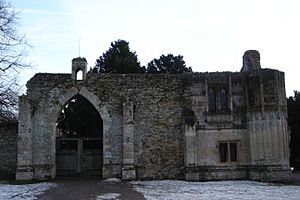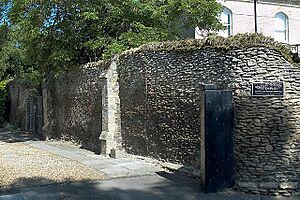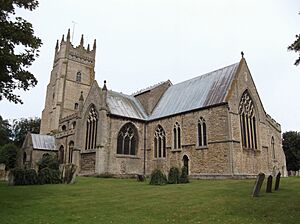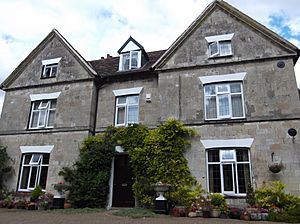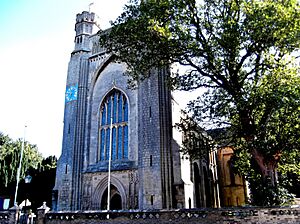List of monastic houses in Cambridgeshire facts for kids
Welcome to a guide about the old religious buildings in Cambridgeshire, England! These buildings are called monastic houses, and they were once homes for groups of people who dedicated their lives to religion. Think of them as special communities where monks, nuns, or friars lived, prayed, studied, and worked together.
These communities played a huge role in history. They were often centers of learning, charity, and farming. Many of them were very powerful and wealthy. But over time, things changed, especially during the 1500s when King Henry VIII closed many of them down in what was called the Dissolution of the Monasteries.
This list will tell you about some of these fascinating places in Cambridgeshire, from grand abbeys to smaller priories and friaries.
What Were Monastic Houses?
Monastic houses were homes for religious orders. These orders were groups of people who followed specific rules and lived a life of prayer and service.
- Monks and Nuns: These groups lived in abbeys or priories. They usually stayed within their community, praying, working, and studying. They often took vows of poverty, chastity, and obedience.
- Friars: Unlike monks and nuns, friars often traveled and preached to people outside their monasteries. They lived in friaries and relied on donations from the public. Different groups of friars had different names, like Augustinian Friars, Franciscan Friars (Greyfriars), Dominican Friars (Blackfriars), and Carmelite Friars (Whitefriars).
- Canons Regular: These were priests who lived in a community under a religious rule, similar to monks, but they also often served local churches.
- Knights Templar and Knights Hospitaller: These were military religious orders. They were warrior-monks who protected pilgrims and cared for the sick, especially during the Crusades. Their homes were called preceptories.
Many of these places were dissolved, meaning they were closed down, and their lands and buildings were taken by the King. Some were completely destroyed, while others were turned into private homes or colleges.
Monastic Houses in Cambridgeshire
Here's a list of some of the monastic houses that once existed in Cambridgeshire. You'll see when they were founded, who lived there, and what happened to them.
| Foundation | Image | Communities and History | Formal Name or Other Names |
|---|---|---|---|
| Anglesey Priory, Lode, Cambridgeshire | Augustinian Canons Regular (a type of priest living in community) Started around 1135 by King Henry I as a hospital, then became a priory around 1212. It was closed down before 1536. Today, parts of it are part of a private house called 'Anglesey Abbey', which is looked after by the National Trust. |
The Priory Church of the Blessed Virgin Mary and Saint Nicholas, Anglesey | |
| Barham Friary | Crutched Friars (a group of friars known for wearing a cross) Founded before 1272. It was closed in 1538. The chapel was used until a house called 'Barham Hall' was built on the site in 1830. |
St Margaret Barkham Priory; Bercham Priory |
|
| Barnwell Priory, Cambridge | Augustinian Canons Regular Moved from another site (St Giles, Castle Hill) and refounded around 1112. It was attacked by townspeople in 1381. Closed on November 11, 1538. The ruins were mostly destroyed in 1810. |
St Giles and St Andrew | |
| Cambridge Austin Friars | Augustinian Friars First founded before 1289, then moved to a new site in 1290. |
||
| Augustinian Friars Moved to this site in 1290. |
|||
| Cambridge Augustinian Priory, Castle Hill, Lode | Augustinian Canons Regular Founded around 1092. The community later moved to Barnwell Priory around 1112. |
St Giles | |
| Cambridge, Bethlehemite Friary (?) | Bethlehemite Friars Mentioned in 1257, but probably never actually built. |
||
| Cambridge Blackfriars | Dominican Friars (also known as Blackfriars because of their black cloaks) Founded before 1238. Closed in 1538. Emmanuel College was built on this site in 1584. |
||
| Blackfriars, Cambridge | Dominican Friars This is a modern foundation, started in 1938, and is still active today. |
The Priory of Saint Michael the Archangel, Cambridge | |
| Cambridge, Buckingham College Priory | Benedictine monks This was a college for monks from Crowland to study in Cambridge. It moved here in 1428. Closed around 1540, then refounded in 1542 as the College of St Mary Magdalene. |
Monk's College | |
| Cambridge, Ely Hostel Priory | Benedictine monks Founded in 1321 for monks from Ely and other places to study. It later moved to a new site. |
||
| Cambridge, Border Hostel Priory | Benedictine monks Moved here in 1350, then moved again to Cambridge, Buckingham College in 1428. |
||
| Cambridge Greyfriars | Franciscan Friars Minor, Conventual (also known as Greyfriars) Founded around 1226, with help from King Edward I. Rebuilt before 1330. Closed in 1538. Sidney Sussex College, Cambridge was founded on this site in 1595. |
||
| Cambridge Pied Friars | Pied Friars (a lesser-known order of friars) Founded around 1256, then moved to a new site in 1273. |
||
| Pied Friars Moved here between 1273 and 1279. Closed after 1319. |
|||
| Cambridge White Friars | Carmelite Friars (also known as Whitefriars) Originally founded in Chesterton in 1247, then moved here in 1249. Closed in 1538. |
||
| Cambridge — Friars of the Sack | Friars of the Sack (a mendicant order, meaning they begged for their living) Founded in 1258 with funding from King Edward I. The site is now occupied by the Fitzwilliam Museum. |
||
| Cambridge — St Mary's Friars | Friars of St Mary Founded around 1279. Closed after 1319. |
||
| Cambridge — St Edmund's Priory | Gilbertine Canons (the only English religious order) Founded before 1291. Closed in 1539. |
The Priory Church of Saint Edmund, Cambridge | |
| Cambridge — St Radegund's Priory | Benedictine nuns Founded around 1133-8. It faced destruction several times. Closed in 1496 to make way for the founding of Jesus College, Cambridge, which is still there today. |
The Priory Church of the Blessed Virgin Mary and Saint Radegund | |
| Chatteris Abbey | Benedictine nuns Founded between 1006 and 1016. Destroyed between 1306 and 1310. Closed on September 3, 1538. |
The Abbey Church of the Blessed Virgin Mary, Chatteris Chateris Abbey |
|
| Chesterton Whitefriars | Carmelite Friars Founded in 1247 or 1249. The community moved to a new site at Newnham in 1249. |
||
| Cherry Hinton | Bridgettine monks and nuns A charter was given for its founding in 1406, but the house was never actually built. |
||
| Chippenham Preceptory | Knights Hospitaller (a military religious order) Founded in 1184. Closed in 1535. |
||
| Denny Abbey | Benedictine monks (1159-1169) Founded in 1159. Then became a Knights Templar preceptory (1169-1308). Later, it was refounded as a home for Franciscan nuns (1423-1539). Closed before 1539. Today, it's part of the Farmland Museum and cared for by English Heritage. |
The Abbey Church of Saint James and Saint Leonard, Denny (1159-69); The Nunnery of the Blessed Virgin Mary and Saint Clare (1342-1539); Denney Abbey; Denney Preceptory |
|
| Duxford Preceptory | Knights Templar (another military religious order) Founded in 1273. Closed between 1308 and 1312. It was attacked during the Peasants' Revolt in 1381. Today, Temple Farm is on the site. |
Duxford Temple | |
| Eltisley Priory | Benedictine nuns Possibly founded in the 9th century, destroyed by the Danes around 870. Refounded before 1066, then closed before 1087. |
||
| Ely Cathedral Priory | This site has a long history! It was a monastery for nuns (and possibly monks) around 673, destroyed by the Danes in 870. Refounded for secular canons (priests not bound by monastic vows) in the 9th century. Then became a home for Benedictine monks in 970. It was dissolved in 1539, but the church became an episcopal (bishop's) cathedral in 1109 and is still active today. |
The Abbey Church of Saint Peter and Saint Etheldreda The Cathedral Church of the Holy and Undivided Trinity and Saint Etheldreda |
|
| Fordham Priory | Gilbertine Canons Founded before 1227. Closed on September 1, 1538. Today, a private house called 'Fordham Abbey' stands on the site. |
The Priory Church of Saint Peter and Saint Mary Magdalene, Fordham | |
| Great Wilbraham Preceptory | Knights Templar Founded in 1170. Closed between 1308 and 1312. Then became a Knights Hospitaller site in 1312, closed around 1350. A house called 'Wilbraham Temple' was built on or near the site in the 17th century. |
Wilbraham Temple | |
| Hinchingbrook Priory | Benedictine nuns Founded before 1087. Closed in 1536. Parts of the priory are now part of the 16th-century Hinchingbrooke House. |
The Priory Church of Saint James, Hinchinbrook The Priory of Saint James without Huntingdon |
|
| Horningsea Monastery | An early Saxon monastery. Destroyed during raids by the Danes in 870. |
Biggin Abbey | |
| Holme Friary | An unknown order of friars, mentioned in 1260. | ||
| Huntingdon Austin Friars | Augustinian Friars Founded in August 1258. Destroyed in 1286 but rebuilt. Closed in 1539. Oliver Cromwell's birthplace, Cromwell House, was built on this site. |
St Mary | |
| Huntingdon Priory, earlier site | Benedictine monks Founded before 973 by King Edgar. Closed before 1086, and the community moved to a new site. |
||
| Huntingdon Priory | Benedictine monks (moved from earlier site) Then became Augustinian Canons Regular around 1086-1091, and again around 1108. Closed on July 11, 1538. |
St Mary | |
| Ickleton Priory | Benedictine nuns Founded in 1190. Closed in 1536. The site is now Abbey Farm. |
The Priory Church of Saint Mary Magdalene, Ickleton Ikelington Priory |
|
| Isleham Priory | Benedictine monks This was an alien house, meaning it was a daughter community of a monastery in France. Founded in 1086 or around 1100. The monks moved to Linton in 1254. Closed in 1414. The church was turned into a barn, and the monastery was demolished. It's now cared for by English Heritage. |
The Priory Church of Saint Margaret of Antioch, Isleham Isleham Cell |
|
| Linton Priory | Benedictine monks Another alien house, also a daughter of the French St-Jacut-de-Mer. Founded before 1163. Monks transferred here from Isleham in 1254. It was restored in the late 19th century. |
St Mary the Virgin | |
| Marmont Priory | Gilbertine Canons Founded before 1204. Closed in 1538. |
The Priory Church of the Blessed Virgin Mary, Marmont Mirmaud Priory; Marmonde Priory; Welle Priory; Welles Priory; Upwell Priory |
|
| Newnham Whitefriars | Carmelite Friars Originally from Chesterton, they moved here in 1249. They stayed until around 1292, then moved to a new site in Cambridge. |
||
| Oxney Priory | Benedictine monks This was a small priory dependent on Peterborough Abbey. Founded before 1272. Closed in 1538. |
St Mary | |
| Peterborough Abbey | This site has a very long history! A Saxon monastery was founded around 655, destroyed by the Danes in 870. It was refounded for Benedictine monks around 966. Closed on November 29, 1539. However, it became an episcopal cathedral in 1540 and is still a major church today. |
The Cathedral Church of Saint Peter, Saint Paul and Saint Andrew, Peterborough Medeshamstede Abbey; Peterburgh Abbey |
|
| Ramsey Abbey | Benedictine monks Founded in 969. Closed on November 22, 1539. Parts of the church were made into a mansion called 'Ramsey House' around 1600. It's now used as a school and is cared for by the National Trust. |
The Abbey Church of Saint Mary and Saint Benedict, Ramsey | |
| St Ives Priory | Benedictine monks This was a small priory dependent on Ramsey. Founded around 1017. Closed in 1539. The site is now a car park. |
St Ive | |
| St Neots Priory | Benedictine monks Founded in 974. It became independent in 1412. Closed in 1539. The site is now a Market Place car park. |
The Priory Church of St Neot, St Neots Eynesbury Priory |
|
| Sawtry Abbey | Cistercian monks (a strict order of Benedictine monks) Founded in 1147. Closed between 1536 and 1537. |
The Blessed Virgin Mary Sawtrey Abbey |
|
| Shingay Preceptory | Knights Hospitaller Founded between 1144 and 1162. It also had a nuns' cell for the Sisters of St. John which moved around 1180. Closed in 1540-1541. |
Shengay Preceptory | |
| Soham Monastery | Saxon monks Founded around 630 or 631. Destroyed during raids by the Danes in 870 or 871. The parish church of St Andrew is believed to be on the same site. |
Seham Monastery | |
| Spinney Abbey | Augustinian Canons Regular Founded between 1216 and 1228. It became dependent on Ely in 1449, then housed Benedictine monks from 1449. Closed in 1538. The site is now a house and farm. |
Priory of St Mary and the Holy Cross, Spinney Spinney Priory |
|
| Stamford — St Michael's Priory | Benedictine nuns Dependent on Peterborough. Founded around 1155. It may have claimed to be Cistercian before 1268. Closed in 1536. |
St Mary and St Michael Stamford Baron Priory; Stamford St Michael's Priory |
|
| Stamford St Sepulchre Priory | Augustinian Canons Regular — Holy Sepulchre Founded around 1170. It later became a hospital, continuing until after 1227. |
||
| Stonely Priory | Possibly started as a hospital. Then became Augustinian Canons Regular around 1180. Closed in 1536. |
The Priory Church of the Blessed Virgin Mary, Stonely | |
| Swaffham Bulbeck Priory | Benedictine nuns Founded around 1150-1163. Closed in 1536. |
The Nunnery of Saint Mary, Swaffham Swaffham Nunnery; Swafam Nunnery |
|
| Swavesey Priory | Benedictine monks This was an alien house, dependent on a French abbey. Founded before 1086. Today, a private house called 'The Priory' is believed to be on or near the site. |
St Andrew | |
| Thirling Cell | Augustinian Canons Regular This was a grange (a farm owned by a monastery) or a small cell. |
Thirling Priory | |
| Thorney Abbey | This site started with anchorites or hermits before 972. Then became a home for Benedictine monks in 972. Closed in 1539. The church is still used by the local parish today. |
The Priory Church of Saint Mary and Saint Botulph, Thorney | |
| Trokenholt Priory | Started as a hermitage. Then became a cell for Benedictine monks dependent on Thorney Abbey. Founded between 1154 and 1169. Closed in the 14th century. |
||
| Waterbeach Abbey | Franciscan nuns Founded in 1294. The community gradually moved to Denny Abbey by 1351 because of flooding. Closed in 1351. |
The Nunnery of the Piety of Our Lady and Saint Clare The Nunnery of Our Lady of Pity and Saint Clare |
|
| Whittlesey Mere Friary | Hermit friars The exact order and founding are uncertain, and there isn't much more information about it. |
||
| Wittering Priory | The order and founding are unknown. A priory was recorded here in 1308. |
Other Places to Know
Some places in Cambridgeshire might sound like monastic houses but aren't:
- Barnwell Priory Abbey: This is actually a church built next to the old Priory Church.
- Buckden Abbey: This is an Elizabethan mansion, not a monastery.
See also


